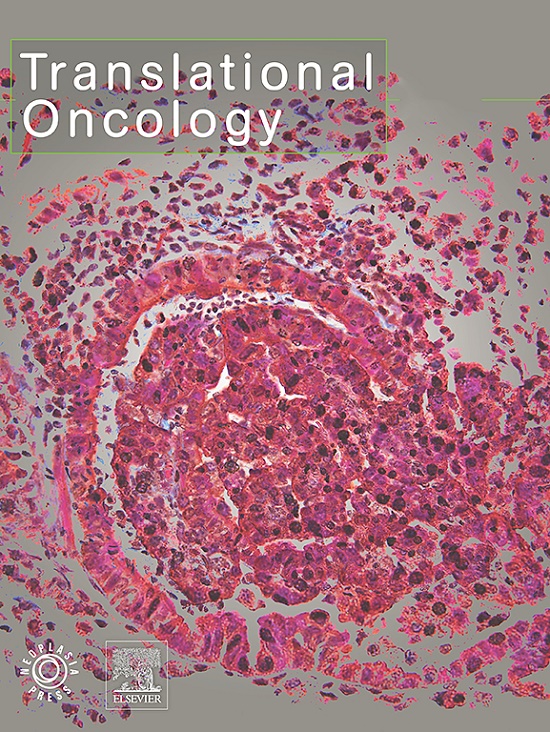NOK 与表皮生长因子受体之间的交叉对话:在乳腺癌肿瘤发生过程中,并膜和激酶结构域的相互作用增强了 STAT3/5 信号的传递。
IF 5
2区 医学
Q2 Medicine
引用次数: 0
摘要
表皮生长因子受体(Epidermal growth factor receptor, EGFR)在细胞增殖和迁移过程中起着重要的调控作用。它与其他ErbB受体家族成员形成同二聚体或异二聚体来激活下游信号。越来越多的证据表明,EGFR活性和下游信号在肿瘤发生过程中受到除其家族成员外的其他蛋白的调节。因此,研究EGFR的不同伙伴关系对于阐明EGFR在肿瘤中介导作用的机制至关重要,这反过来又可以指导靶向治疗策略的发展。在这里,我们报道了NOK(也称为STYK1),一种新型酪氨酸激酶与EGFR交叉对话,促进乳腺癌细胞的肿瘤发生和转移。我们发现NOK直接与EGFR相互作用,并通过它们的近膜结构域和激酶结构域以交叉相互作用的方式形成异源二聚体复合物。NOK的缺失损害了EGFR的磷酸化,但NOK的过表达增加了。NOK通过近膜结构域(JM)增强egf诱导的STAT3和STAT5的磷酸化,促进乳腺癌细胞的增殖和迁移。NOK和EGFR的过表达可协同诱导NIH-3T3正常细胞的肿瘤发生。我们证明了NOK和EGFR的共同表达与乳腺癌患者的肿瘤恶性分期相关。我们的发现介绍了EGFR-NOK通过近膜(JM)结构域和激酶结构域的一种新的交叉相互作用方式,揭示了NOK在肿瘤发生和转移过程中协调EGFR增强EGF-STAT3/5信号的机制,并提出了靶向NOK-EGFR治疗乳腺癌的潜在策略。本文章由计算机程序翻译,如有差异,请以英文原文为准。

Cross-Talk between NOK and EGFR: Juxtamembrane and Kinase domain interactions enhancing STAT3/5 signaling in breast cancer tumorigenesis
Epidermal growth factor receptor (EGFR) plays an important role in the regulation of cell proliferation and migration [1]. It forms a homodimer or heterodimer with other ErbB receptor family members to activate downstream signaling. Emerging evidence indicates that the EGFR activity and downstream signaling are regulated by other proteins except its family members during tumorigenesis. Hence, investigating the diverse partnership profiles of EGFR is crucial for elucidating the mechanisms underlying EGFR-mediated actions in tumors, which in turn can guide the development of targeted therapeutic strategies. Here we report that NOK (also known as STYK1), a novel tyrosine kinase cross-talks with EGFR to promote tumorigenesis and metastasis of breast cancer cells. We found that NOK directly interacted with EGFR and formed a heterodimer complex in a manner of cross interaction via their juxtamembrane (JM) domains and kinase domains. Depletion of NOK impaired, but over-expression of NOK increased, the phosphorylation of EGFR. NOK enhanced EGF-induced phosphorylation of STAT3 and STAT5 via its juxtamembrane (JM) domain in promoting the proliferation and migration of breast cancer cells. Overexpression of NOK and EGFR synergistically induced the tumorigenesis of NIH-3T3 normal cells. We demonstrated that co-expression of NOK and EGFR correlated with tumor malignant stages in breast cancer patients. Our finding introduces a new cross interaction manner of EGFR-NOK via juxtamembrane (JM) domains and kinase domains, uncovers a mechanism by which NOK coordinates EGFR to enhance EGF-STAT3/5 signaling during tumorigenesis and metastasis, and proposes a potential strategy for targeting NOK-EGFR in breast cancer treatment.
求助全文
通过发布文献求助,成功后即可免费获取论文全文。
去求助
来源期刊

Translational Oncology
ONCOLOGY-
CiteScore
8.40
自引率
2.00%
发文量
314
审稿时长
54 days
期刊介绍:
Translational Oncology publishes the results of novel research investigations which bridge the laboratory and clinical settings including risk assessment, cellular and molecular characterization, prevention, detection, diagnosis and treatment of human cancers with the overall goal of improving the clinical care of oncology patients. Translational Oncology will publish laboratory studies of novel therapeutic interventions as well as clinical trials which evaluate new treatment paradigms for cancer. Peer reviewed manuscript types include Original Reports, Reviews and Editorials.
 求助内容:
求助内容: 应助结果提醒方式:
应助结果提醒方式:


